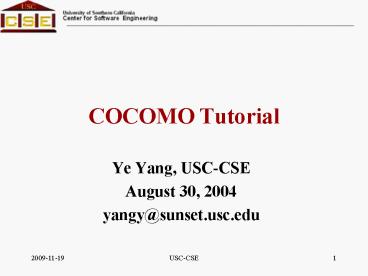COCOMO Tutorial - PowerPoint PPT Presentation
1 / 9
Title:
COCOMO Tutorial
Description:
COCOMO II is the update to COCOMO 1981 ... COCOMO II described in new book ' ... Development Flexibility (FLEX) Need to conform with specified requirements ... – PowerPoint PPT presentation
Number of Views:1173
Avg rating:5.0/5.0
Title: COCOMO Tutorial
1
COCOMO Tutorial
- Ye Yang, USC-CSE
- August 30, 2004
- yangy_at_sunset.usc.edu
2
COCOMO Background
- COCOMO - the COnstructive COst MOdel
- COCOMO II is the update to COCOMO 1981
- ongoing research with continuous calibrations
made available - Originally developed by Dr. Barry Boehm and
published in 1981 book Software Engineering
Economics - COCOMO II described in new book Software Cost
Estimation with COCOMO II - COCOMO can be used as a framework for cost
estimation and related activities
3
COCOMO Black Box Model
product size estimate
development, maintenance cost and schedule
estimates
cost factors
COCOMO II
reuse, maintenance, and increment parameters
cost, schedule distribution by phase, activity,
increment
organizational project data
recalibration to organizational data
4
Cost Factors
- Significant factors of development cost
- scale drivers are sources of exponential effort
variation - cost drivers are sources of linear effort
variation - product, platform, personnel and project
attributes - effort multipliers associated with cost driver
ratings - Defined to be as objective as possible
- Each factor is rated between very low and very
high per rating guidelines - relevant effort multipliers adjust the cost up or
down
5
Scale Drivers
- Precedentedness (PREC)
- Degree to which system is new and past experience
applies - Development Flexibility (FLEX)
- Need to conform with specified requirements
- Architecture/Risk Resolution (RESL)
- Degree of design thoroughness and risk
elimination - Team Cohesion (TEAM)
- Need to synchronize stakeholders and minimize
conflict - Process Maturity (PMAT)
- SEI CMM process maturity rating
6
Cost Drivers
- Product Factors
- Reliability (RELY)
- Data (DATA)
- Complexity (CPLX)
- Reusability (RUSE)
- Documentation (DOCU)
- Platform Factors
- Time constraint (TIME)
- Storage constraint (STOR)
- Platform volatility (PVOL)
- Personnel factors
- Analyst capability (ACAP)
- Program capability (PCAP)
- Applications experience (APEX)
- Platform experience (PLEX)
- Language and tool experience (LTEX)
- Personnel continuity (PCON)
- Project Factors
- Software tools (TOOL)
- Multisite development (SITE)
- Required schedule (SCED)
7
Sizing
- Source Lines of Code (SLOCs)
- Logical source statements data declarations
executable statements - KSLOCs, thousand source lines of code
- Executable statements cause runtime actions
- Declaration statements are nonexecutable
statements that affect an assembler's or
compiler's interpretation of other program
elements - Codecount tool available on USC web site
- Other sizing methods
- Function Point Counting
- UML-based sizing
8
Software Estimation Accuracy
- Effect of uncertaintiesover time
9
Major Decision SituationsHelped by COCOMO II
- Software investment decisions
- When to develop, reuse, or purchase
- What legacy software to modify or phase out
- Setting project budgets and schedules
- Negotiating cost/schedule/performance tradeoffs
- Making software risk management decisions
- Making software improvement decisions
- Reuse, tools, process maturity, outsourcing































